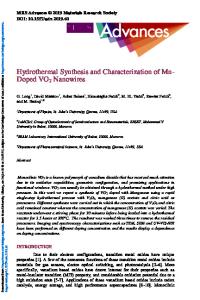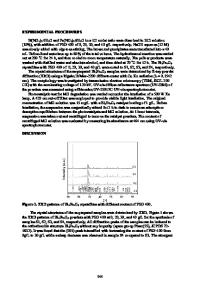Hydrothermal synthesis and visible light photocatalytic activities of Zn 3 (VO 4 ) 2 nanorods
- PDF / 525,576 Bytes
- 8 Pages / 584.957 x 782.986 pts Page_size
- 27 Downloads / 476 Views
Zn 3 (VO4) 2 nanorods with visible light-driven photocatalytic activity were prepared by hydrothermal reaction and characterized by x-ray diffraction, Fourier transform infrared, scanning electron microscopy, x-ray photoelectron spectroscopy, UV–vis diffuse reflectance spectra, and Brunauer–Emmett–Teller surface area and pore size analyzer. The Zn 3 (VO4 ) 2 nanorods consisted of rods with a thickness of approximately 30 nm, length in the range 400–600 nm, and width in the range 150–250 nm. The photocatalytic degradation activities for methylene blue (MB) and 4-nitrophenol (4-NP) over the Zn 3 (VO4) 2 nanorods were studied in detail. The photocatalytic activity of the as-prepared photocatalyst for MB and 4-NP in visible light under the same conditions was about 3.5 times and 2.5 times higher than that of N–TiO2, respectively. The main active species in the photodegradation come from dOH, and the photogenerated electrons also partly involved in the photocatalytic degradation process, in which the dOH radicals formed were in proportional to the light illumination time obeying zero-order reaction rate kinetics.
I. INTRODUCTION
Semiconductor photocatalysts have been researched extensively because of their applications for environmental purification and energy conversion.1 Among semiconductor photocatalysts, TiO2 is most widely used due to its nontoxicity, stability, and efficient photocatalytic activity.2 However, nanostructured TiO2 suffers from low efficiency under visible light illumination since it has a large band gap energy of 3.2 eV.3 Therefore, a lot of research works have been carried out to improve TiO2 as a visible light active photocatalyst, including dye-sensitizing, metal-doping, nonmetal-doping, and coupling of two semiconductors.4–7 Although the light absorption was extended to a visible light region, these processes often suffered from a multistep synthesis process or involved an increase in the carrier–recombination centers.8–10 These methods are not appropriate for developing highly efficient visible light active photocatalysts. At present, exploiting non-TiO2-based photocatalysts with high visible light photocatalytic activity is important and desirable. Recently, non-TiO2 visible light active photocatalysts based on vanadate have received increased attention owing to their efficient photocatalytic activity under a)
Address all correspondence to this author. e-mail: [email protected] DOI: 10.1557/jmr.2014.334 2934
J. Mater. Res., Vol. 29, No. 24, Dec 28, 2014
http://journals.cambridge.org
Downloaded: 13 Mar 2015
visible light irradiation.11 Visible light active silver vanadate photocatalysts were successfully synthesized using a simple hydrothermal process, and the samples had higher photocatalytic activities than those of P25 (Ref. 12); Large-scale, high-purity, and uniform BiVO4 nanoribbons have been synthesized by a facile hydrothermal route, and the nanoribbons showed superior photocatalytic activities in the degradation of eosin Y under visible light irradiation13; A series of vanadate grafted T
Data Loading...











